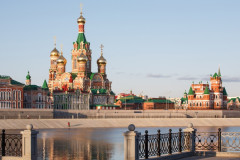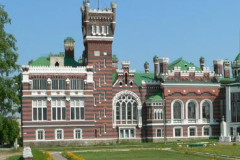Mari El
Description
The Mari El Republic is a federal subject of Russia (a republic). Its capital is the city of Yoshkar-Ola. As of the 2010 Census, the population of the Mari El Republic was 696,459.
Geography
The republic is located in the eastern part of the East European Plain of Russia, along and mostly to the north the Volga River. The swampy Mari Depression is in the west of the republic, contrasted by more hilly landscapes in the east where the highest point of the republic (at 278 meters (912 ft)) is located. The republic borders with Kirov Oblast in the north and east, the Republic of Tatarstan in the southeast and south, the Chuvash Republic in the south, and with Nizhny Novgorod Oblast in the west and north. The are 476 rivers in the republic, with the Volga and its tributaries being the major water arteries. Most rivers are considered to be minor—10–50 meters (33–164 ft) wide and 0.5–1.4 meters (1 ft 8 in–4 ft 7 in) deep—and usually freeze between mid-November and mid-April. There are over 700 lakes and ponds; many located in the swampy areas and having areas of less than 1 square kilometer (0.39 sq mi) and depths between 1 and 3 meters (3 ft 3 in and 9 ft 10 in). Lake Yalchik, occupying 150 hectares (370 acres), is the largest by area, while Lake Tabashinskoye is the deepest. Swamps cover large areas—10–70 square km and up to 100 square km—and usually freeze in December. While swamps tend to be shallow, with an average depth of 0.5–1.5 meters (1 ft 8 in–4 ft 11 in), they are impassable in fall and spring due to flooding.
Climate is moderately continental, with moderately cold and snowy winters and warm and often rainy summers. The average temperatures range from 18–20 °C (64–68 °F) in summer to −18 – −20 °C (0 – −4 °F) in winter. November is the windiest month of the year. Annual precipitation varies from 450 to 500 millimeters (18 to 20 in).
There are virtually no natural resources of industrial significance in the republic. Other resources include peat, mineral waters, and limestone. About 50% of the republic's territory is forested, although the level of forestation varies significantly from one district to another.
History
Ancient Mari tribes were known since the 5th century, though archeologists suspect Mari culture to be much older in its roots. Later their area was a tributary of Volga Bulgaria and the Golden Horde. In the 1440s it was incorporated into the Khanate of Kazan and was occupied by the Tsardom of Russia (governed by Ivan the Terrible) after the fall of Kazan in 1552.
After the Russian Revolution, under the Bolshevik regime, the Mari Autonomous Oblast was established on November 4, 1920. It was re-organized into the Mari ASSR on December 5, 1936, at the same time as the enactment of the 1936 Soviet Constitution (a.k.a. the "Stalin Constitution"). In its present form the Mari El Republic was formed on December 22, 1990.
Culture
There are many museums located throughout the territory of the republic. The largest ones include the National Museum, the Museum of History, and the Museum of Fine Arts in Yoshkar-Ola; the Museum of Arts and History, the Ethnographic Open-Air Museum, and the Merchant Life Museum in Kozmodemyansk; and the Sheremetevo Castle Museum-reserve in Yurino. There are also museums dedicated to the poet Nikolay Mukhin and the composer Ivan Klyuchnikov-Palantay in Yoshkar-Ola and the house-museum of writer Sergei Chavayn in Chavaynur.
Five theaters are located in Yoshkar-Ola with performances in both the Russian and Mari languages, though it should be noted that the Mari National Theater, a major ethnic institution, was closed by the government. The International Helsinki Federation for Human Rights (IHF) and Moscow Helsinki Group (MHG) in their 2006 report "Russian Federation: The Human Rights Situation of the Mari Minority of the Republic of Mari El", reported "The closure of the Mari National Theater, which had been a key element of Mari cultural life ever since its foundation in 1919, was perceived as a direct attack on Mari culture."
Tourism
The territory of the republic is one of the more ecologically pure areas of the European part of Russia with numerous lakes, rivers, and forests. As a result, it is a popular destination for tourists looking to enjoy nature. One of the most popular destinations is Marii Chodra national park in the Ilet valley, where visitors can enjoy various activities such as boating, horseback riding, fishing, and mushrooming. Another is the Bolshaya Kokshaga National Reserve, where visitors can walk through virgin forests and observe local wildlife.
Mari El is also the site of several mineral springs, many of which are located in the Ilet valley. Many small resorts and children's camps are also located on the various lakes throughout the republic.


